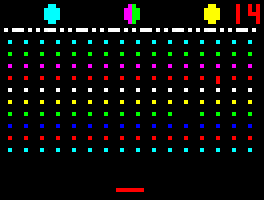General Information
The HUG1802 was designed around 1978 in New Zealand by Hugh Anderson, where HUG in the name was refering to Hugh. In 1978 and 1979 more than 100 boards were sold through a company called Kitparts N.Z. In 1979 Kitparts sold the idea to the Australian ETI (Electronics Today International) magazine, who re-worked the PCB, renamed it to ETI-660 and published it as a DIY kit.
Changes in the ETI 660 compared to the HUG1802 were as follows: the 2708 was replaced with a single-supply 2516, the colour circuitry was modified to use a standard 390nS TV delay line, and the keypad was replaced with keyswitches. This work was done by Graeme Teesdale.
No changes were made to memory maps, or the ROM, and as a result, anything that ran on a HUG1802 would run on an ETI 660. Hugh is the designer of the ROM (a CHIP8 interpreter and monitor with tape I/O) as well as HUG-BASIC-1K and HUG-CHESS of which binary files were recently made available by Hugh.
The design was very similar to the Cosmac VIP and Telmac 2000. Like the Telmac 2000 the ETI 660 also used the CDP 1864 for video but the supplied system rom was also able to handle the 64 x 48 resolution and included a chip-8 interpreter.
In 2023, Costas Skordis, redesigned the HUG1802 using a CDP1861 instead of the more difficult to find CDP1864. , this redesign is called the HEC1802.
Technical specifications
Clock: 1.773 MHz
Memory:
1 - 3 KB RAM and 256 x 4 bit colour RAM
1 - 2 KB ROM
Video: CDP1864 (CDP1861 in the HEC1802)
Sound: CDP1864 (CDP1861 in the HEC1802)
Keyboard: MC6821
Screen shot
ETI-660 running the colour game Wipeout.
Links
Other information about the HUG1802, ETI-660 and HEC1802:

Here is an index of the different ETI-660 articles (thanks to Herb Johnson):
May 1981
- Want to get into microcomputers without boiling your brain cells or breaking the bank? - Part 1, general description of the ETI-660
- Introducing The HUG 1802 Microprocessor - advertisement for the original HUG1802
June 1981
- A Learners' microcomputer - Part 2, 1802 vs 6800, 8080
October 1981
- A Learners' microcomputer - Part 3, construction, PCB
November 1981
- A Learners' microcomputer - Part 4, chip-8 ROM hex listing, schematics
- Programming in Chip-8 - a crash course
- Note:- See July 1982 for a ROM correction
January 1982
- 660 software: Mastermind
February 1982
- 660 software: '660 Invaders, Patternmaker
March 1982
- Useful book for Cosmac VIP/ETI-660 owners
- 660 software: Addition problems
April 1982
- How to score - '660 Programming
- Programming the '660 in colour (... painting by numbers!)
May 1982
- 660 software: Video Drawing
- Note:- See June 1982 for a Video Drawing correction
June 1982
- Chip-8 column: COSMAC Asteroids
- 660 software: Space Dogfight
- Errata: Video Drawing
July 1982
- Bad Byte in the CHIP-8 Monitor EPROM (IC11) - correction to chip-8 ROM in ETI-660
- 660 software: Color Patternmaker
- Chip-8 column: Cosmac Life
August 1982
- 660 software: Catch 660, How the 'Color Patternmaker' works
- Chip-8 column: Subroutine variable store/restore
September 1982
- 660 software: Dice, Greeblie Catcher
October 1982
- 660 software: Wipeout 660, Traditional Space Invaders
- Note:- See February 1983 for a Traditional Space Invaders correction
November 1982
- 660 software: Black Jack, Word 60, Skeet Shooot, Block Puzzle, Meteor Storm, Space Invaders MK III
- Note:- See February 1983 for Black Jack improvements
December 1982
January 1983
February 1983
- 660 software: Iago for Two, Asteroid Shower, Patches, Select A Game
- Notes & Errata: Traditional Space Invaders, Black Jack
March 1983
- 660 software: Character Generator and Video Message Maker
April 1983
- 660 software: Noughts & Crosses, Asteroid Shower, Polaris, Squash
May 1983
- 660 software: Print Routine, Guessing Game
June 1983
- 660 software: Block Move, Tank Battle
July 1983
- 660 software: TV Message Maker/Inventory, Memory Display Utility
- Note:- See November 1983 for a Memory Display Utility correction
August 1983
- 660 software: Sequencer, Table Tennis, Gobble, One Byte Shifter
- Cure for Colour Problems
- Note:- See November 1983 for a Gobble correction
September 1983
- 660 software: Pakman
October 1983
November 1983
- 660 software: Polaris II, Lunar Blitz, Bombs Away, Alternative Block Puzzle, IAGO for Two Updated, Pakman Problems
- Notes & Errata: Memory Display Utility, Gobble
December 1983
January 1984
- The COMX 35 - some promise there - might not belong in this list but a nice read all the same!
- Joystick Modification
- 660 software: Block Extermination
February 1984
May 1984
- Chip-8 column: Mazegazing, Random Warbler
July 1984
- Chip-8 column: Loop the Block, '660 Kong, 3D Maze
- Note:- See September 1984 for a 3D Maze correction
September 1984
- Chip-8 column: Amazing, Chip8 Character Generator, Mastermind
- Errata: 3D Maze
October 1984
- Proportional Analogue Joystick for the ETI-660
- Chip-8 column: Picture Shifter Subroutine, Submarine Defence
Main Features HUG1802, ETI-660 & HEC1802 Emulators
- Adjustable speed, boosting the speed of the HUG1802/ETI-660 beyond 1.773 MHz!
- Tape support (wav file and real cassette support) including a Turbo version
- Direct ETI 660 memory access to load and save software from the PC hard disk via intel hex or binary files
- Video support for CDP1864 with zoom and full screen option by pressing F3
- Sound support for CDP1864
- Video screen dump to a file (BMP, JPEG, PNG or PCX image)
- Memory mode for either 1KB ROM and 3KB RAM or 2KB for both
- Support for Chip 8 interpreter included in ETI 660 system rom
